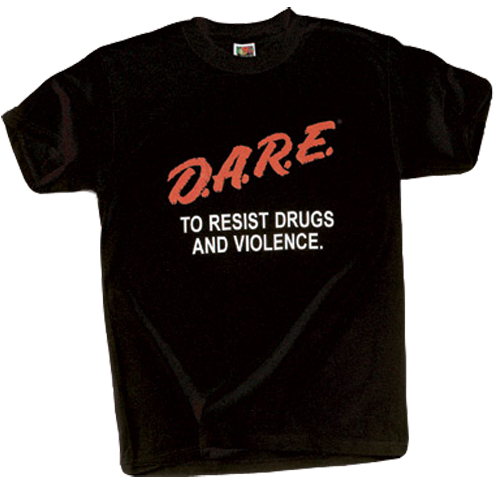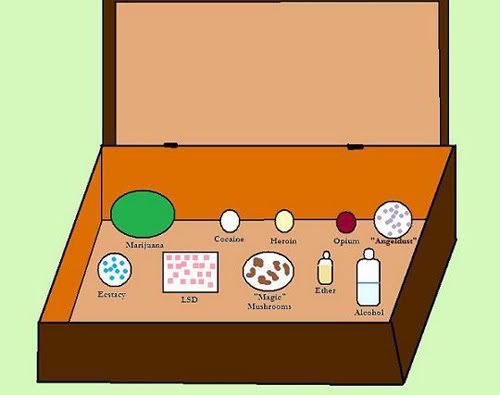
I’m sitting in my fifth grade classroom at Rolling Hills Elementary School, thinking about hard-core drugs—cocaine, heroin, speed, pcp. Why am I thinking about hard-core drugs in my fifth grade classroom? Because the police officer standing at the front of the classroom has just opened a treasure chest of real hard-core drugs, and he is showing them to us, talking about what they do. This is called the D.A.R.E. (Drug Abuse Resistance Education) program.
I must admit that, more than anything, I am fascinated by these drugs. They represent a darker world—a world of gangs and crime and violence—which are pretty absent from my sleepy suburb in Fullerton. These drugs represent the world I see on TV, when I watch Air Wolf or the A-Team or CHiPS. But these drugs are real. If he wanted, officer Dan could open his treasure chest and we could all get totally loaded right here in class.
I don’t think these are the thoughts I am supposed to be having. I am supposed to be horrified, appalled by these drugs and the dark world they represent. But mostly, I am just curious. If I am the “good kid” in class and these are my thoughts, what must the “bad kids” be thinking? They are probably thinking of ways to steal officer Dan’s chest of goodies. They will unleash pandora’s box at Rolling Hills Elementary school.
Looking back, I think the D.A.R.E. program was pretty worthless. It didn’t prevent me, or most of my friends, from trying drugs. I think a much more effective drug-prevention program would be to take kids to Narcotics Anonymous (NA) meetings, and have them listen to and see real people whose lives have been destroyed by drugs.
Out of curiosity, I looked into scientific/academic studies of the effectiveness of the D.A.R.E. program. I got this off Wikipedia, but there are links to the actual academic articles on that site, which I think is the most useful feature of wikipedia. Here’s what the experts have to say:
-Researchers at Indiana University, commissioned by Indiana school officials, found that those who completed the D.A.R.E. program subsequently had significantly higher rates of hallucinogenic drug use than those not exposed to the program.
-A report to the California Department of Education by Joel Brown Ph. D. stated that none of California's drug education programs worked, including D.A.R.E. "California's drug education programs, D.A.R.E. being the largest of them, simply don't work. More than 40 percent of the students told researchers they were 'not at all' influenced by drug educators or programs. Nearly 70 percent reported neutral to negative feelings about those delivering the antidrug [sic] message. While only 10 percent of elementary students responded to drug education negatively or indifferently, this figure grew to 33 percent of middle school students and topped 90 percent at the high school level." Read the report HERE.
-A grant from the National Institute of Justice to the University of Maryland resulted in a report to the NIJ, which among other statements, concluded that "D.A.R.E. does not work to reduce substance use.” D.A.R.E. expanded and modified the social competency development area of its curriculum in response to the report. Research by Dr. Dennis Rosenbaum in 1998, found that D.A.R.E. graduates were more likely than others to drink alcohol, smoke tobacco and use illegal drugs. Psychologist Dr. William Colson asserted in 1998 that D.A.R.E. increased drug awareness so that "as they get a little older, they (students) become very curious about these drugs they've learned about from police officers.” The scientific research evidence in 1998 indicated that the officers were unsuccessful in preventing the increased awareness and curiosity from being translated into illegal use. The evidence suggested that, by exposing young impressionable children to drugs, the program was, in fact, encouraging and nurturing drug use. Studies funded by the National Institute of Justice in 1998, and the California Legislative Analyst's Office in 2000 also concluded that the program was ineffective.
-A ten year study was completed by the American Psychological Association in 2006 involving one thousand D.A.R.E. graduates in an attempt to measure the effects of the program. After the ten year period no measurable effects were noted. The researchers compared levels of alcohol, cigarette, marijuana and the use of illegal substances before the D.A.R.E. program (when the students were in sixth grade) with the post D.A.R.E. levels (when they were 20 years old). Although there were some measured effects shortly after the program on the attitudes of the students towards drug use, these effects did not seem to carry on long term.
-In 2001, the Surgeon General of the United States, David Satcher M.D. Ph.D., placed the D.A.R.E. program in the category of "Does Not Work." The U.S. General Accountability Office concluded in 2003 that the program was sometimes counterproductive in some populations, with those who graduate from D.A.R.E. later having higher rates of drug use (a boomerang effect).
-In March 2007, the D.A.R.E. program was placed on a list of treatments that have the potential to cause harm in clients in the APS journal, Perspectives on Psychological Science.
It seems that overwhelming evidence suggests that D.A.R.E. is indeed worthless. This wouldn’t be so bad, were it not for the fact that the program gets millions of dollars of taxpayer dollars to keep going. This is just one more example of America’s failed “war on drugs.”

